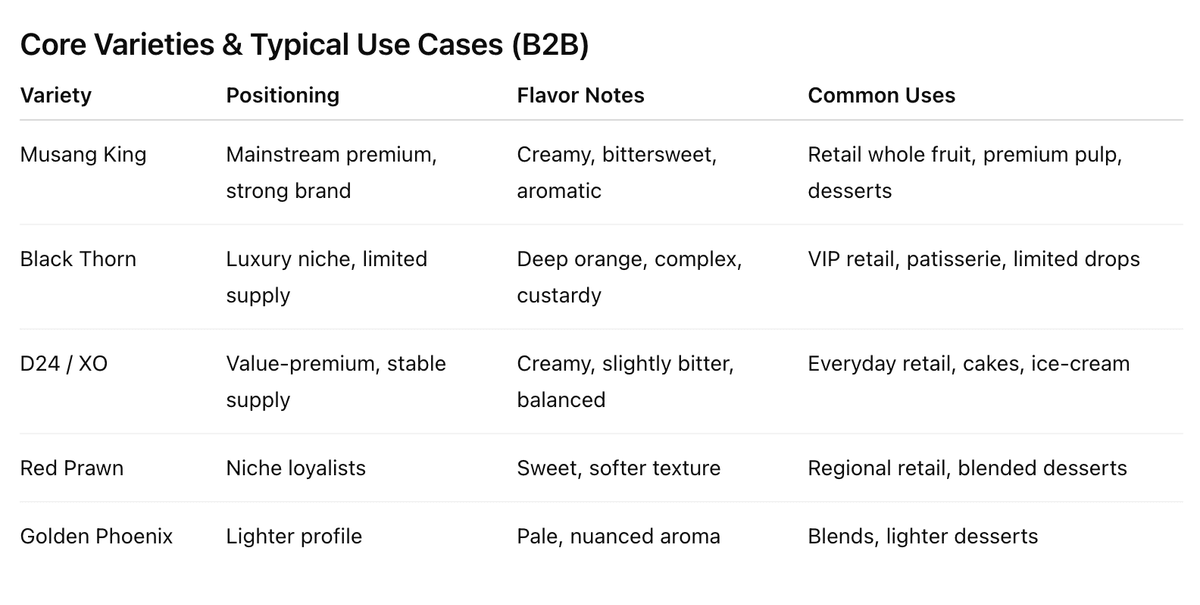Who This Guide Is For
- Distributors and wholesalers scaling beyond retail volume
- Supermarkets, grocers, and specialty fruit stores
- F&B manufacturers (bakeries, ice-cream, beverages)
- E-commerce sellers and livestream commerce operators
Wholesale Basics: Fresh vs Frozen
Fresh whole durian
- Best for: premium retail, gifting, PR launches
- Pros: higher perceived value, social virality
- Cons: short shelf life; strict temperature control (typically 15–18 °C)
Frozen pulp/pods
- Best for: manufacturers, supermarkets, year-round SKUs
- Pros: 6–12 months shelf life at ≤-18 °C; predictable quality
- Cons: less “theatre” than fresh; packaging and cold-chain costs
Winning mix for most buyers: run both—fresh for spike events, frozen for steady margins.

Price Realities (Typical Wholesale Ranges, 2025)
Ranges vary by harvest window, grade, size, and logistics.
- Musang King (fresh, whole): ~USD 8–12/kg
- Black Thorn (fresh, whole): ~USD 10–15/kg
- D24/XO (fresh, whole): ~USD 5–7/kg
- Frozen pulp/pods (any variety): ~USD 4–8/kg (spec-dependent)
How to protect margin: mix high-turn D24/XO with limited MSK/Black Thorn; anchor frozen contracts to smooth seasonality.
Seasonality & Supply Planning (Malaysia Focus)
- Peak harvests: mid-year and late-year flushes (shifts by region/weather)
- Best practice: lock forecasts 4–8 weeks ahead; pre-book cold-store and freight
- Tiering: allocate limited Black Thorn to VIP packs; reserve MSK for retail headliners; keep D24/XO as steady value
Grading, Size & Quality Checks
External grading
- Shell: no cracks, minimal spines damage
- Size: avoid oversize (2.5–3.0 kg+) unless your packaging fits it
- Stem: fresh cut, not overly dried
Internal indicators (when possible)
- Flesh color by variety, texture uniformity
- Maturity: avoid under-ripe; ask for orchard maturity protocol
- Photo sampling per pallet; random open checks when feasible
For frozen
- Brix target by variety; pulp color consistency
- Micro and heavy metal compliance (spec sheet)
- Organoleptic sampling against golden lot
Packaging That Reduces Claims
Fresh (whole fruit) cartons
- Reinforced corners; correct venting to reduce sweating
- Clear labels: variety, lot, net weight, origin, storage temp
- Palletization: cross-strapped, corner boards; temp logger per pallet
Frozen pulp/pods
- Food-grade liners; nitrogen flush or vacuum where relevant
- Carton prints: variety, spec, batch/lot ID, production date, storage temp
- Retail: bilingual panels (EN/中文), prominent variety names
Logistics & Incoterms (Fast Primer)
Common Incoterms for durian
- EXW / FCA: buyer organizes export leg; useful for experienced importers
- FOB: seller delivers to port of shipment; buyer handles main carriage
- CIF/CFR: seller covers freight (and insurance for CIF); smoother for new buyers
- DAP/DDP: near-door delivery; more cost but lowest friction for the buyer
Mode choice
- Airfreight (fresh): premium, ≤48-hour orchard-to-airport target
- Reefer sea (frozen): economical scale; maintain ≤-18 °C throughout
Singapore as consolidation hub
- Close to Malaysian orchards; strong cold-chain and re-label capacity
- Practical for mixing varieties, relabeling, and meeting airline/reefer schedules
MOQs, Lead Times & Payment Terms
Fresh: often by pallet/ULD (discuss mixed pallets if needed)
Frozen: 1,000–5,000 kg common for manufacturers; retail cases by negotiated tiers
Lead times:
- Fresh: 3–10 days planning; tighter during peak festival windows
- Frozen: 2–4 weeks for production/booking; longer during high season
Payment terms:
- New buyers: deposit + balance against documents
- Repeat buyers: move toward 30/70, or structured credit with history
Risk Control: 10 Mistakes to Avoid
- Over-ordering oversized fruit that doesn’t fit your cartons
- Skipping pre-shipment photo/video sampling
- Under-investing in cartons and liners (false economy)
- Missing temperature loggers → weak claims position
- Incomplete labels (variety/origin/lot) → delays at inspection
- No backup flight/reefer options in peak weeks
- Paying spot premiums without forecasting
- Buying Black Thorn without a plan to monetize scarcity
- Ignoring Brix/maturity specs on frozen pulp
- Not aligning product mix with your channel (retail vs manufacturer)
Due Diligence on Suppliers: Quick Checklist
- Orchard provenance (state/region), photos, and season plan
- Certifications and export experience
- SOPs for maturity, grading, and rejection handling
- Cold-chain partners, routes, and escalation contacts
- Example documents: invoice, packing list, COO, phyto, HS code mapping
- References from repeat buyers; sample claim resolution cases
30-Day Execution Plan (First Purchase Cycle)
Week 1
- Finalize product mix (fresh retail SKUs + frozen B2B)
- Issue RFQs; shortlist suppliers; request golden-lot samples
Week 2
- Align packaging specs and labeling; confirm MOQs and terms
- Book cold-store and freight options; define Plan B routes
Week 3
- Place initial PO; run photo sampling per pallet; assign temp loggers
- Prepare receiving SOPs in destination (QC bay, core temp checks)
Week 4
- Receive shipment; log QC results; file learnings into spec updates
- Negotiate 3–6 month framework based on sell-through and claims
FAQs
What’s the best variety for first-time wholesale buyers?
Musang King is the safest premium starter due to brand recognition and steady supply. Pair with D24/XO for value volume.
How do I reduce claims on fresh shipments?
Invest in cartons, pre-cool correctly, cap oversized fruits, use temp loggers, and insist on photo sampling per pallet.
What frozen specs do manufacturers prefer?
Clean pulp or pods in 1 kg or 10 kg formats, spec sheet with Brix and micro results, and stable supply under a 6–12 month contract.
What’s a sensible MOQ if I’m testing the market?
One mixed pallet/ULD for fresh, or 1,000–2,000 kg for frozen. Scale once your channel proves throughput.
Is Singapore worth the extra step?
For many buyers, yes—the hub reduces variability with better consolidation, labeling, and freight reliability, which often nets higher sellable yield.

